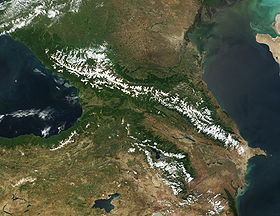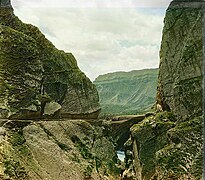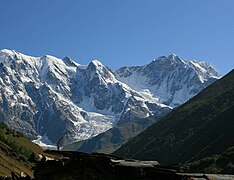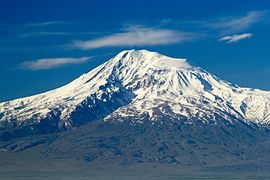Winter Mountains in Caucasus 3 Piece Graphic Art on Wrapped Canvas Set
| Caucasus Mountains | |
|---|---|
 Aeriform view of the Caucasus Mountains | |
| Highest point | |
| Peak | Mount Elbrus |
| Elevation | five,642 m (xviii,510 ft) |
| Coordinates | 43°21′18″North 42°26′31″E / 43.35500°N 42.44194°E / 43.35500; 42.44194 |
| Dimensions | |
| Length | 1,200 km (750 mi) |
| Width | 160 km (99 mi) |
| Geography | |
| Topographic map | |
| Countries | Armenia, Azerbaijan, Georgia, Iran, Russia and Turkey |
| Continent | Eurasia |
| Range coordinates | 42°30′N 45°00′E / 42.five°N 45°Due east / 42.v; 45 Coordinates: 42°30′N 45°00′Eastward / 42.v°Due north 45°E / 42.v; 45 |

Satellite prototype of the Caucasus Mountains
The Caucasus Mountains [a] is a mount range at the intersection of Asia and Europe. Stretching betwixt the Black Body of water and the Caspian Bounding main, it is surrounded by the Caucasus region and is home to Mount Elbrus, the highest top in Europe at 5,642 metres (18,510 ft) above sea level.
The Caucasus Mountains include the Greater Caucasus in the north and Lesser Caucasus in the southward. The Greater Caucasus runs west-northwest to e-southeast, from the Caucasian Natural Reserve in the vicinity of Sochi, Russia on the northeastern shore of the Blackness Sea to Baku, Azerbaijan on the Caspian Body of water. The Lesser Caucasus runs parallel to the Greater about 100 km (62 mi) southward.[i] The Greater and Lesser Caucasus ranges are continued past the Likhi Range, and to the west and east of the Likhi Range prevarication the Colchis Manifestly and the Kur-Araz Lowland. The Meskheti Range is a part of the Lesser Caucasus system. In the southeast, the Aras River separates the Lesser Caucasus from the Talysh Mountains which straddles the border of southeastern Azerbaijan and Iran. The Lesser Caucasus and the Armenian Highland constitute the Transcaucasian Highland, which at their western end converges with the highland plateau of Eastern Anatolia in the far north east of Turkey. Mountains near Sochi hosted part of the 2014 Wintertime Olympics.
Geology [edit]
Geologically, the Caucasus Mountains belong to the Alpide belt organisation that extends from southeastern Europe into Asia[2] and is considered a edge between the ii continents.[3] The Greater Caucasus Mountains are mainly equanimous of Cretaceous and Jurassic rocks with the Paleozoic and Precambrian rocks in the higher regions. Some volcanic formations are found throughout the range. On the other hand, the Lesser Caucasus Mountains are formed predominantly of the Paleogene rocks with a much smaller portion of the Jurassic and Cretaceous rocks. The evolution of the Caucasus began from the Late Triassic to the Late Jurassic during the Cimmerian orogeny at the active margin of the Tethys Ocean while the uplift of the Greater Caucasus is dated to the Miocene during the Alpine orogeny.
The Caucasus Mountains formed largely as the effect of a tectonic plate collision between the Arabian Plate moving northwards with respect to the Eurasian Plate. As the Tethys Sea was closed and the Arabian Plate collided with the Iranian Plate and was pushed against it and with the clockwise movement of the Eurasian Plate towards the Iranian Plate and their final collision, the Iranian Plate was pressed against the Eurasian Plate. As this happened, the entire rocks that had been deposited in this basin from the Jurassic to the Miocene were folded to form the Greater Caucasus Mountains. This collision too caused the uplift and the Cenozoic volcanic activity in the Bottom Caucasus Mountains.[four]
The unabridged region is regularly subjected to stiff earthquakes from this activity.[v] While the Greater Caucasus Mountains accept a mainly folded sedimentary structure, the Lesser Caucasus Mountains are largely of volcanic origin.[6]
The Javakheti Volcanic Plateau in Georgia and the surrounding volcanic ranges which extend well into central Armenia are some of the youngest features of the region. Only recently was the Caucasus a scene for intense volcanic activity: the Armenian highland was flooded by calc-alkaline basalts and andesites in the Pliocene and the highest summits of the Caucasus, the Elbrus, and the Kazbek, formed as Pleistocene-Pliocene volcanoes. The Kazbek is no longer active, but the Elbrus erupted in postglacial times and fumarole action is registered near its tiptop. Gimmicky seismic action is a prominent feature of the region, reflecting active faulting and crustal shortening. Clusters of seismicity occur in Dagestan and in northern Armenia. Many devastating earthquakes have been documented in historical times, including the Spitak convulsion in December 1988 which destroyed the Gyumri-Vanadzor region of Armenia.
Notable peaks [edit]
Mount Elbrus, at five,642 g (18,510 ft), in the Caucasus Mountains, is sometimes cited as the highest peak in Europe. Mount Elbrus is 832 m (ii,730 ft) higher than Mont Blanc, the highest elevation in the Alps and Western Europe at 4,810 m (15,780 ft). However, at that place are some technical disagreements over whether Mountain Elbrus is in Europe.[seven] The crest of the Greater Caucasus Mountains is usually taken to define the Greater Caucasus Watershed which marks the continental boundary between Asia and Europe for the region between the Black and Caspian seas, this classification would place Mount Elbrus at the junction with Asia.[3]
The table below lists some of the highest peaks of the Caucasus. With the exception of Shkhara, the heights are taken from Soviet 1:50,000 mapping. The list includes the ten ultras (mountains of more than 1,500 yard prominence) and all mountains over four,500 m height with 300 g prominence. Mount Ararat (five,137 m) in Turkey is but south of the Bottom Caucasus.
-
Some of the Highest peaks in the Caucasus Mountains Peak proper noun Height
(metres)Prominence
(metres)State Elbrus 5,642
4,741
Russia Dykh-Tau 5,205
2,002
Russia Shkhara 5,193[b]
1,365
Georgia / Russia Koshtan-Tau v,152
822
Russian federation Pushkin pinnacle 5,100
110
Russia Janga
(Dzhangi-Tau)5,085
300
Georgia / Russia Mizhirgi v,047
ten
Russian federation Kazbek 5,034
ii,353
Georgia / Russia Katyn-Tau 4,979
240
Georgia / Russia Kukurtlu Dome 4,978
18
Russia Gistola 4,860
320
Georgia / Russia Shota Rustaveli four,860
c. 50
Georgia / Russian federation Tetnuldi four,858
672
Georgia Dzhimara
(Jimari)4,780
840
Georgia / Russia Ushba 4,710
1,143
Georgia Dumala-Tau 4,682
332
Russia Gora Uilpata four,649
1300
Russia Tikhtengen 4,618
768
Georgia / Russian federation Ailama 4,547
one,067
Georgia / Russia Tiutiun-Tau 4,540
380
Russian federation Jailik 4,533
926
Russia Salinan 4,508
621
Russia Tebulosmta four,499
2,145
Georgia / Russia Mount Bazardüzü four,466
2,454
Republic of azerbaijan / Russia Gora Shan 4,451
1,775
Georgia / Russia Tepli iv,431
1,144
Russian federation Diklo iv,285
843
Georgia / Russia Mountain Shahdagh 4,243
one,102
Republic of azerbaijan Gora Addala
Shukgelmezr4,152
ane,792
Russia Gora Dyultydag 4,127
one,834
Russian federation Aragats four,090
2,143
Armenia Deavgay 4,016
1,251
Russia
Climate [edit]

The climate of the Caucasus varies both vertically (according to elevation) and horizontally (by latitude and location). Temperature generally decreases as superlative rises. Boilerplate almanac temperature in Sukhumi, Abkhazia at sea level is 15 °C (59 °F) while on the slopes of Mt.Kazbek at an elevation of 3,700 metres (12,100 ft), average annual temperature falls to −6.1 °C (21.0 °F). The northern slopes of the Greater Caucasus Mountain Range are 3 °C (5.iv °F) colder than the southern slopes. The highlands of the Lesser Caucasus Mountains in Armenia, Azerbaijan, and Georgia are marked by sharp temperature contrasts between the summer and winter months due to a more than continental climate.
Precipitation increases from east to west in about areas. Elevation plays an of import office in the Caucasus and mountains more often than not receive college amounts of precipitation than low-lying areas. The northeastern regions (Dagestan) and the southern portions of the Lesser Caucasus Mountains are the driest. The absolute minimum annual precipitation is 250 mm (ix.84 in) in the northeastern Caspian Depression. Western parts of the Caucasus Mountains are marked by loftier amounts of precipitation. The southern slopes of the Greater Caucasus Mountain Range receive higher amounts of precipitation than the northern slopes. Annual atmospheric precipitation in the Western Caucasus ranges from i,000 to 4,000 mm (39.37–157.48 in) while in the Eastern and Northern Caucasus (Chechnya, Ingushetia, Kabardino-Balkaria, Ossetia, Kakheti, Kartli, etc.) atmospheric precipitation ranges from 600 to 1,800 mm (23.62–seventy.87 in). The absolute maximum annual precipitation is 4,100 mm (161.42 in) effectually the Mt. Mtirala area which lies on the Meskheti Range in Ajaria. The precipitation of the Bottom Caucasus Mountain Range (Southern Georgia, Armenia, western Azerbaijan), not including the Meskheti Range, varies from 300-800 mm (31.50 in) annually.
The Caucasus Mountains are known for the high amount of snowfall, although many regions which are not located along the windward slopes do not receive near every bit much snow. This is specially true for the Lesser Caucasus Mountains which are somewhat isolated from the moist influences coming in from the Black Ocean and receive considerably less precipitation (in the grade of snowfall) than the Greater Caucasus Mountains. The average winter snow cover of the Lesser Caucasus Mountains ranges from 10 to thirty cm (3.94–11.81 in). The Greater Caucasus Mountains (especially the southwestern slopes) are marked by heavy snow. Avalanches are mutual from November to April.
Snow cover in several regions (Svaneti and northern Abkhazia) may reach 5 metres (16 ft). The Mt. Achishkho region, which is the snowiest identify in the Caucasus, often records snow depths of vii m (23 ft).
Landscape [edit]

Khodz river headwaters, Western Caucasus
The Caucasus Mountains have a varied mural which mainly changes according to elevation and distance from big bodies of water. The region contains biomes ranging from subtropical lowland marshes and forests to glaciers (Western and Key Caucasus), and highland semideserts, steppes, and alpine meadows in the south (mainly in Armenia and Azerbaijan).
The northern slopes of the Greater Caucasus Mountains are covered past oak, hornbeam, maple, and ash forests at lower elevations while birch and pine forests take over at higher elevations. Some of the lowest areas of the region are covered by steppes and grasslands. The slopes of the Northwestern Greater Caucasus (Kabardino-Balkaria, Cherkessia, etc.) likewise comprise spruce and fir forests. The alpine zone replaces the forest at around 2,000 metres (six,600 ft) above sea level. The permafrost/glacier line generally starts around two,800–3,000 metres (nine,200–ix,800 ft). The southeastern slopes of the Greater Caucasus Mountains are covered by beech, oak, maple, hornbeam, and ash forests. Beech forests tend to boss in higher locations. The southwestern slopes of the Greater Caucasus are covered by Colchian forests (oak, buxus, beech, anecdote, hornbeam, elm) at lower elevations with coniferous and mixed forests (spruce, fir and beech) taking over at higher elevations. The alpine zone on the southern slopes may extend upwardly to 2,800 metres (9,200 ft) above sea level while the glacier/snowfall line starts at 3,000–3,500 metres (9,800–11,500 ft).
The northern and western slopes of the Lesser Caucasus Mountains are characterized both past Colchian and other deciduous forests at lower elevations while mixed and coniferous forests (mainly spruce and fir) dominate at higher elevations. Beech forests are too common at higher elevations. The southern slopes of the Bottom Caucasus Mountains are largely covered past grasslands and steppes upwardly to an elevation of ii,500 metres (viii,200 ft). The highest areas of the region comprise tall grasslands as well. Volcanic and other rock formations are mutual throughout the region. The volcanic zone extends over a big area from southern Georgia into Armenia and southwestern Azerbaijan. Some of the prominent peaks of the region include Mt. Aragats, Didi Abuli, Samsari, and others. The area is characterized past volcanic plateaus, lava flows, volcanic lakes, volcanic cones and other features. The Lesser Caucasus Mountains lack the type of glaciers and glacial features that are mutual on the Greater Caucasus Mountain Range.
History [edit]
Crossing the Caucasus Mountain range was an important section of the northern arm of the Silk Road. In that location was 1 pass on the southeast end in Derbent (known as the Caspian Gates or Gates of Alexander), and multiple passes throughout the range: Jvari Pass at 2379 one thousand and above the Darial Gorge on the Georgian Military Road, Mamison Pass on the Ossetian Military Road at 2911 m, and Roki Tunnel at 2310 1000.
Image gallery [edit]
-

-

-

-

-

Asbestnaya Mountain and Acheshbok Mount, Russia
-

Bolshoy Tkhach Park, Russia
Come across also [edit]
- Zagros Mountains
Notes [edit]
- ^ Native names:
- Georgian: კავკასიონი , romanized: k'avk'asioni,
- pronounced [kʼɑvkʼɑsiɔni]
- Armenian: Կովկասյան լեռներ, Kovkasyan leṙner
- pronounced [kɔvkɑsjɑn lɛrˈnɛɾ]
- Azerbaijani: Qafqaz dağları, pronounced [qɑfqɑz dɑʁlɑrɯ]
- Russian: Кавка́зские го́ры , tr. Kavkázskiye góry , IPA: [kɐfˈkasːkʲɪje ˈɡorɨ]
- Turkish: Kafkas Dağları, Turkish pronunciation: [kafkas daːɫaɾɯ]
- Persian: كوه هاى قفقاز
- ^ The tiptop and coordinates given here are taken from a DGPS survey by Peter Schoen and Boris Avdeev, in clan with "GeoAT". . It was carried out in July 2010 and "made available". November 2010. in November 2010.
References [edit]
- ^ Stokes, Chris R. (2011). Singh, Vijay P.; Haritashya, Umesh M. (eds.). Encyclopedia of Snow, Ice and Glaciers. Spring Science & Business Media. p. 127. ISBN978-ninety-481-2641-5.
- ^ Sharkov, E.; Lebedev, V.; Chugaev, A.; Zabarinskaya, L.; Rodnikov, A.; Sergeeva, N.; Safonova, I. (2015-07-01). "The Caucasian-Arabian segment of the Tall-Himalayan collisional belt: Geology, volcanism and neotectonics". Geoscience Frontiers. 6 (4): 513–522. doi:10.1016/j.gsf.2014.07.001. ISSN 1674-9871.
- ^ a b National Geographic Maps (House) (2011), Atlas of the world, Washington, D.C.: National Geographic Club, ISBN978-1-4262-0632-0, OCLC 671359683, retrieved 2021-01-09
- ^ Adamia, Shota; Zakariadze, Guram; Chkhotua, Tamar; Sadradze, Nino; Tsereteli, Nino; Chabukiani, Aleksandre; Gventsadze, Aleksandre (Jan 2011). "Geology of the Caucasus: A Review" (PDF). Turkish J. Earth Sci. 20: 489–544.
- ^ Reilinger, R. Due east.; McClusky, S. C.; Oral, M. B.; King, R. W.; Toksoz, M. N.; Barka, A. A.; Kinik, I.; Lenk, O.; Sanli, I. (January 1997). "Global Positioning System measurements of present-day crustal movements in the Arabia-Africa-Eurasia plate collision zone". Journal of Geophysical Research. 102 (B5): 9983–9999. Bibcode:1997JGR...102.9983R. doi:10.1029/96JB03736.
- ^ Philip, H.; Cisternas, A.; Gvishiani, A.; Gorshkov, A. (one April 1989). "The Caucasus". Tectonophysics. 161 (one–2): 1–21. Bibcode:1989Tectp.161....1P. doi:10.1016/0040-1951(89)90297-seven.
- ^ "Mt. Elbrus". NASA Globe Observatory. NASA. 7 July 2003. Archived from the original on 15 December 2018. Retrieved 16 February 2015.
- Parts of this article are from the NASA World Observatory: "Mt. Elbrus". Earth Observatory (image & text). newsroom / new images. NASA. 12 September 2000. Archived from the original on 2005-10-28.
Further reading [edit]
- Cornell, Svante East. (1 December 2000). Small-scale Nations and Great Powers: A report of ethnopolitical conflict in the Caucasus (1st ed.). Routledge. ISBN978-070071162-8.
Sets out a synthesis of the Caucasian conflicts and a conclusion on the identify of the Caucasus in world diplomacy.
External links [edit]
- "Caucasus Mountains". NASA Earth Observatory. 7 November 2001.
- "Highest Peaks of the Caucasus from peakbagger.com". Peakbagger.com.
- "List of the most prominent mountains in the Caucasus". Peaklist.org.
- "What to see in Caucasus Mountains" (tourism promotion / commercial). Archived from the original on 2020-ten-24. Retrieved 2021-09-20 .
florancehoughts1992.blogspot.com
Source: https://en.wikipedia.org/wiki/Caucasus_Mountains

0 Response to "Winter Mountains in Caucasus 3 Piece Graphic Art on Wrapped Canvas Set"
Post a Comment